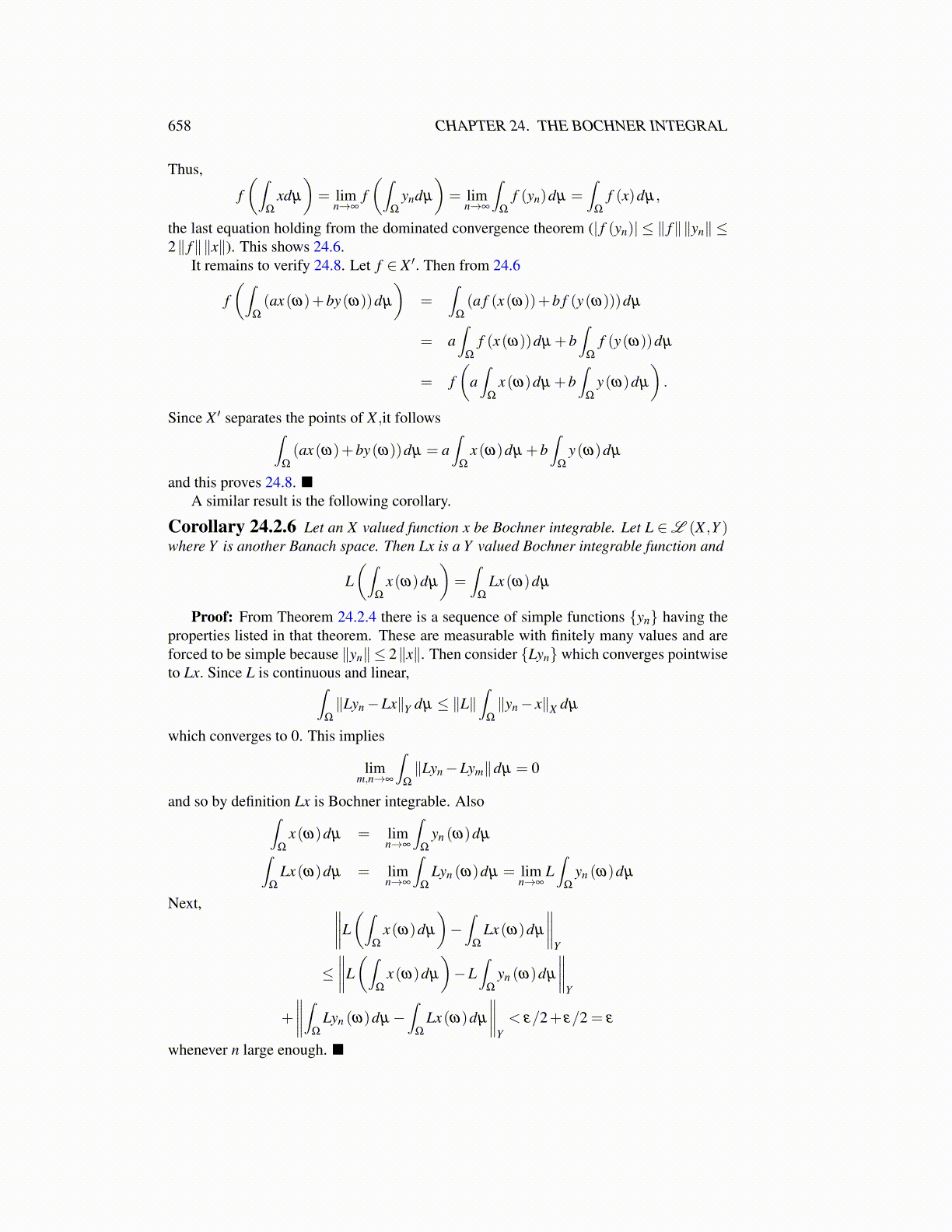
658 CHAPTER 24. THE BOCHNER INTEGRAL
Thus,
f(∫
Ω
xdµ
)= lim
n→∞f(∫
Ω
yndµ
)= lim
n→∞
∫Ω
f (yn)dµ =∫
Ω
f (x)dµ,
the last equation holding from the dominated convergence theorem (| f (yn)| ≤ ∥ f∥∥yn∥ ≤2∥ f∥∥x∥). This shows 24.6.
It remains to verify 24.8. Let f ∈ X ′. Then from 24.6
f(∫
Ω
(ax(ω)+by(ω))dµ
)=
∫Ω
(a f (x(ω))+b f (y(ω)))dµ
= a∫
Ω
f (x(ω))dµ +b∫
Ω
f (y(ω))dµ
= f(
a∫
Ω
x(ω)dµ +b∫
Ω
y(ω)dµ
).
Since X ′ separates the points of X ,it follows∫Ω
(ax(ω)+by(ω))dµ = a∫
Ω
x(ω)dµ +b∫
Ω
y(ω)dµ
and this proves 24.8. ■A similar result is the following corollary.
Corollary 24.2.6 Let an X valued function x be Bochner integrable. Let L ∈L (X ,Y )where Y is another Banach space. Then Lx is a Y valued Bochner integrable function and
L(∫
Ω
x(ω)dµ
)=∫
Ω
Lx(ω)dµ
Proof: From Theorem 24.2.4 there is a sequence of simple functions {yn} having theproperties listed in that theorem. These are measurable with finitely many values and areforced to be simple because ∥yn∥ ≤ 2∥x∥. Then consider {Lyn} which converges pointwiseto Lx. Since L is continuous and linear,∫
Ω
∥Lyn−Lx∥Y dµ ≤ ∥L∥∫
Ω
∥yn− x∥X dµ
which converges to 0. This implies
limm,n→∞
∫Ω
∥Lyn−Lym∥dµ = 0
and so by definition Lx is Bochner integrable. Also∫Ω
x(ω)dµ = limn→∞
∫Ω
yn (ω)dµ∫Ω
Lx(ω)dµ = limn→∞
∫Ω
Lyn (ω)dµ = limn→∞
L∫
Ω
yn (ω)dµ
Next, ∥∥∥∥L(∫
Ω
x(ω)dµ
)−∫
Ω
Lx(ω)dµ
∥∥∥∥Y
≤∥∥∥∥L(∫
Ω
x(ω)dµ
)−L
∫Ω
yn (ω)dµ
∥∥∥∥Y
+
∥∥∥∥∫Ω
Lyn (ω)dµ−∫
Ω
Lx(ω)dµ
∥∥∥∥Y< ε/2+ ε/2 = ε
whenever n large enough. ■